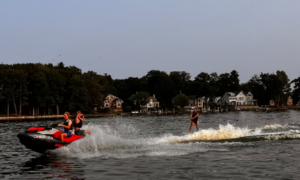Sr. Elliot Dozeman swiftly cuts across the calm, blue water of Lake Michigan on his jet ski. Turning into the channel, the now turbulent water catches his jetski’s side, flipping him and his friend over. Stuck under their jetski in Holland’s crowded channel, Dozeman and his friend struggle to escape from underneath. Luckily, they were both wearing life jackets, helping them stay afloat. “If I wasn’t wearing a life jacket, I wouldn’t have floated to the side and I don’t know what could have happened. I could have hit my head or still been stuck underneath,” Dozeman said. 
The life jacket started as a cork vest in 1854, and some 170 years later, it is still constantly evolving and improving. Master Captain Jon Meyer has been working with boats his whole life. He trains captains and boat owners, and he does municipal water safety training. “Life jackets are an absolute necessity when near the water. During a boat accident, people often get the wind knocked out of them. Boats don’t have seat belts.” Meyer said.
Meyer shares that people under the age of 6 (or less than 90 lbs) must wear a life jacket while boating in Michigan. Drowning is the leading cause of death in boating accidents and almost 85% of people were NOT wearing a life jacket, according to the United States Coast Guard Auxiliary.
“Water safety in Holland is so important as we live by two lakes. The Holland area is somewhat compliant, and if you research drownings in the area, 100% would have been prevented by wearing a life vest,” Meyer said. With Michigan being the third largest boating and recreational water sports state, many people spend time on the water. When water safety is not practiced, things can go wrong, and using a life jacket is the strongest precaution that an individual can have in place.
Many students at West Ottawa spend their summer on the water. With Holland being located by two lakes, there are always opportunities to get out on the water. “When I’m jet skiing a life jacket is required, and when I’m fishing I’ll have a life jacket or a throwable on board with me. It’s a reminder to take it easy out there, you can’t be goofing around because bad things can always happen and you have to stay safe,” Sr. Elliot Dozeman said. No matter what activities you are doing, safety is always important. “I go tubing, boating, and paddle boarding during the summer. Life jackets are really important because they keep you safe in case you get hurt. One time when I was tubing and the driver made a mistake, resulting in the wind getting knocked out of me and if I wasn’t wearing my life jacket, I would have drowned.” Soph. Lily Uzelac said.
There are many companies, government agencies, and nonprofits advocating for the use of life jackets. Peg Phillips is the Executive Director of the National Safe Boating Council (NSBC), an organization that promotes water safety education. “We work with a coalition of individuals and families who have been involved in a boating or open water tragedy. They have lost a loved one, or been injured in an incident. These dedicated families and their stories are the reason behind what we do. In so many cases, death and injury could have been avoided if the person had been wearing a life jacket, an engine cut-off lanyard, boating sober, or practicing other boating safety behaviors.” Phillips said. The National Safe Boating Council (NSBC) has a program called the Safe Boating Campaign (Wear It!) where you can pledge to wear a life jacket and operate boats safely. “Through our outreach campaigns, we offer free resources from our warehouse. We have everything from children’s books, and educational flyers, to dry bags and wristbands!” Phillips said.
“We hope to create a boating safety culture where wearing a life jacket is the norm, like wearing a seatbelt in a vehicle. If this behavior change happens, we can reduce deaths and injuries from boating incidents by large numbers,” Phillips said. So next time you are on the water, make sure you have a life jacket to help keep yourself safe and prevent the loss of lives due to drowning.
About the Contributor
Anne Uzelac is the vice president of the Interact club, a member of DECA, and a volunteer at both the JDRF and the First Tee. She enjoys reading, spending time on the water, and playing golf along with tennis.





